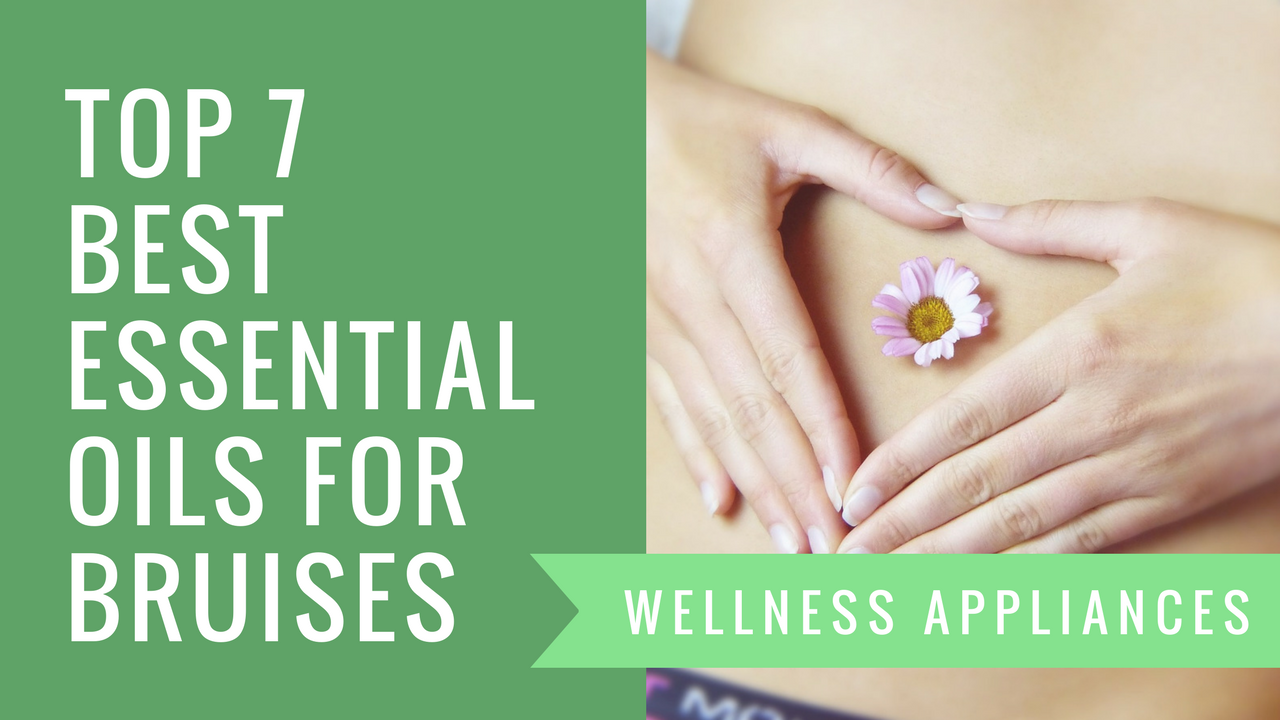Contents
Bruises are often painful, swollen and not pleasant to looks at. But thankfully bruising is a temporary condition that improves over time. Regardless of the cause of injury the waiting time for bruises to heal can be frustrating and uncomfortable.
When this is the case, it’s natural to want to propel the healing process, and a great way of doing this is to use Essential Oils for bruises to reduce pain, inflammation and increase blood flow to that area of skin, which in turn will help that bruise disappear.

Why Do Bruises Form?
Bruising occurs for many reasons. It could be from a sprained ankle, a fall, something hitting the body, a missed step, an injection, surgery and so on. The reasons why bruising might occur are vast and wide, but the healing cycle is always the same. However, some bruising may take longer to heal, depending on the cause.
Typically, a bruise is a result of a blow to the skin that causes capillaries (tiny blood vessels that can be found near to the surface of your skin) to break. These broken vessels leak blood in the surrounding tissues. This is what causes the dis-coloration beneath the skin surface and makes it tender to touch.
As the skin heals, your body begins to act as a vacuum, clearing up leaked blood caused on impact. When this stage in the healing process begins the colour in a bruise starts to change. This happens at a slower rate than is sometimes wanted or needed in order to get back to a normal routine with no pain. It’s natural to want to a speedy recovery, and frustrating when we realise we’re at the mercy of the body’s natural healing process.
How You Can Help the Healing Process
When a part of the body has been bruised, it is often accompanied with swelling, inflammation and pain. When inflammation occurs, it generally means, that blood flow to that specific area is slower than its natural pace. When circulation through this area passes freely with no obstruction, it means that the injury will heal at a faster rate.
There are many essential oils that come rich in anti-inflammatory properties that can speed up the body’s natural recovery process by reducing inflammation and increasing blood flow to the affected area.
Take a look at the typical healing process of a bruise:
| Changes in appearance | Life cycle |
| Day 1: Pink/Red | Upon impact lasting up to 24 hours or so |
| Days 2 – 6: Blue/Dark Purple | Usually appears on the 2nd day lasting until day 6 |
| Days 6 – 7: Light Green | On the 6th day the colour will begin to lighten as blood flow increases to the area |
| Days 7 – 14: Yellow/Light Brown | Around the 7th day through to the 14th, the last stage of the body’s re-absorption process will begin to reduce the colour further until finally the affected area returns to a natural skin colour |
How to Speed Natural Recovery
We can support the body’s natural recovery process by doing a number of things. The body is a vastly intelligent organism made up of a cellular structure that reacts to external factors, such as temperature. When the body is cold, blood flow reduces. When the body is warm, blood flow increases.
Having this awareness, we can manipulate blood flow around an injured area of skin, so that blood flow can be slowed down to reduce bruising and swelling, and sped up, for the body’s natural healing process to clear up the leaked blood.
When injury incurs and a bruise is anticipated there are four basic care practices to adopt in reducing swelling, inflammation and dis-coloration: These are known as: Ice, Heat, Compression and Elevation. This basic care regime can also be supported through several essential oils.
Essential Oil
There are 7 essential oils that can be applied topically ‘during and after’ basic care practices. The powerful natural compounds found in essential oils will aid the body’s natural recovery process and can be integrated into the following basic care practices of an injury.
Ice Therapy
Upon impact, it’s always best to apply ice, immediately. The low temperature from the ice will slow blood flow to the area, reducing the amount of blood passing into the surrounding tissue, which can result in less of a bruise and reduce swelling. The perfect essential oil to combine with this technique is outlined below.
Heat
Once the injury has been limited, the bruising has begun to show and the healing process is underway, heat therapy can be applied. This may seem confusing going from ice to heat, but be aware that there will be a definitive time in between the blood leakage stopping, and the body’s ability to begin the clean-up process.
The heat will help the blood trapped beneath the skin to aid the body’s vacuum action which is carried through the blood stream. Essential oils that work best with this practice can be found below.
Compression
By wrapping the injured area in an elastic bandage, this will squeeze the tissues and help prevent blood vessels from further leakage. It can also reduce the severity of the bruise, lessen pain and limit swelling. This practice is especially effective when used with key essential oils – outlined in the next section.
Elevation
It helps to elevate the bruised area so that it is above the heart. This is a good way of supporting the body’s natural vacuum action to help drain fluid away from the injury and could also relieve pain. For the best essential oils to use with this practice, see below.
7 Essential Oil Remedies
Essential oils come packed with natural ability to assist the human body in its healing functions. Even the most severe bruising will eventually heal. This list of essential oils come rich in anti-inflammatory properties with pain reducing power.
- Geranium
- Cypress
- Rosemary
- Lemongrass
- Lavender
- Frankincense
- Helichrysum
1. Geranium Essential Oil
Geranium Essential Oil is a flowering plant known to increase circulation to the area of bruising and stimulate the production of healthy, new tissue. This may actually result in increased inflammation at first but you will find the healing process will develop much faster.
This oil was also used by the Egyptians to promote the skin’s radiance, and mixed with the sweet-smelling aroma of the Geranium, your mind will feel relaxed whilst your body heals.
Benefits:
- Anti-inflammatory – Reduces swelling which may reduce pressure causing pain and increase blood flow which can help speed up the healing process.
- Dermatologically tested – Because not all skin types are the same, this oil can be used on sensitive skin. A known ingredient to help treat eczema, acne and dermatitis.
How to use Geranium Essential Oil:
- Aromatically: Diffuse 1-2 drops – This will no doubt relax the mind while the body rests and heals.
- Topically:
- Massage: Dilute 1-2 drops (depending on the brand and size of affected area – increase if the essential oil is less potent or the area is bigger than a small bruise) with a carrier oil (arnica oil) and massage into the skin.
- Gentle massage will also help to break down leaked blood below the skin.
- Compression: Apply 1-2 drops to a carrier oil and spread onto an elastic bandage or towel. Secure in place around the bruised area.
- Heat: Apply 1-2 drops to carrier oil and spread onto a heated towel. Leave to warm the affected area.
- Apply any of the above twice daily.
- Can also be added to a warm bath (1-2 drops)
2. Cypress Essential Oil
Cypress Essential Oil is your ‘bad bruise’ best friend. The cypress is considered to be the medical tree with many specific botanical features. This oil has the power to effectively block the pooling and the collection of blood beneath the skin’s surface. It will stimulate circulation and rapidly speed the beginning of the healing process.
Benefits:
- Anti-inflammatory – Reduces swelling which may reduce pressure causing pain and increase blood flow which can help speed up the healing process.
- Antiseptic – With antiseptic properties this essential oil can be applied to cuts as well as bruises.
- Antispasmodic – Generally speaking, when a bruise occurs, the muscle can often be affected too. Cypress essential oil packs powerful compounds that will both soothe muscle pulls or strains and heal bruises at the same time.
How to use Cypress Essential Oil:
- Aromatically: Diffuse 1-2 drops – this oil is a great way of filling the air around you with a scent that promotes peace and calm. During your healing process, this may come in handy.
- Topically:
- Can be used direct after Ice therapy to stop the pooling of blood.
- Massage: Dilute 1-2 drops (depending on the brand and size of affected area – increase if the essential oil is less potent or the area is bigger than a small bruise) with a carrier oil (arnica oil) and massage into the skin.
- Gentle massage will also help break down leaked blood below the skin.
- Compression: Apply 1-2 drops to carrier oil and spread onto an elastic bandage or towel. Secure in place around the bruised area.
- Heat: Apply 1-2 drops to carrier oil and spread onto a heated towel. Leave to warm the affected area.
- Apply any of the above twice daily.
- Can also be added to a warm bath (1-2 drops)
3. Rosemary Essential Oil
Rosemary has been used since ancient times, growing in the Mediterranean region it has been used in cooking for as long as can be remembered. Yet, moving out of the kitchen, one of its great powers lends itself to relaxing joints and muscles, and relieving pain, fast.
Benefits:
- Anti-inflammatory – Reduces swelling which may reduce pressure causing pain and increase blood flow which can help speed up the healing process.
- Antiseptic – With antiseptic properties this essential oil can be applied to cuts as well as bruises.
How to use Rosemary Essential Oil:
- Aromatically: Diffuse 1-2 drops – This fresh aroma may help put a spring in your senses.
- Topically:
- Massage: Dilute 1-2 drops (depending on the brand and size of affected area – increase if the essential oil is less potent or the area is bigger than a small bruise) with a carrier oil (arnica oil) and massage into the skin.
- Massage will also help to break down leaked blood below the skin.
- Compression: Apply 1-2 drops to carrier oil and spread onto an elastic bandage or towel. Secure in place around the bruised area.
- Heat: Apply 1-2 drops to carrier oil and spread onto a heated towel. Leave to warm the affected area.
- Apply any of the above twice daily.
- Can also be added to a warm bath (1-2 drops
4. Lemongrass Essential Oil
Lemongrass Essential Oil is one of the most versatile and health-promoting essential oils with its analgesic strength being just one from a long list. Limonene, one of its beneficial compounds is known to reduce inflammation and is considered to be among the top 6 best anti-inflammatory oils available.
Benefits:
- Anti-inflammatory – Reduces swelling which may reduce pressure causing pain. Increases blood flow which can help speed up the healing process.
- Anti-bacterial – If a bruise is accompanied by cuts, this oil’s anti-bacterial compounds will help to prevent infection.
- Analgesic – This oil has the power to actively relieve pain.
How to use Lemongrass Essential Oil:
- Aromatically: Diffuse 1-2 drops – An oil with zing! Not only is this a richly compounded oil, the fragrance is light and zesty due to its citrus content.
- Topically:
- Massage: Dilute 1-2 drops (depending on the brand and size of affected area – increase if the essential oil is less potent or the area is bigger than a small bruise) with carrier oil (arnica oil) and massage into the skin.
- Massage will also help to break down leaked blood below the skin.
- Compression: Apply 1-2 drops to carrier oil and spread onto an elastic bandage or towel. Secure in place around the bruised area.
- Heat: Apply 1-2 drops to carrier oil and spread onto a heated towel. Leave to warm the affected area.
- Apply any of the above twice daily.
- Can also be added to a warm bath (1-2 drops)
5. Lavender Essential Oil
Lavender Essential Oil is steeped in reported history from the Egyptians with their purifying rituals, the romans with their cleansing practices, and a 17th century London when lavender was considered a hero amongst the threat of the Great Plague. Lavender has many healing and cleansing properties, such as anti-inflammatory, analgesic and antiseptic, to name a few.
Benefits:
- Anti-inflammatory – Reduces swelling which may reduce pressure causing pain. Increases blood flow which can help speed up the healing process.
- Antiseptic – Cuts often accompany bruises, dependent on the injury, and this oil can work to clean the wound, as well as treating the bruised area.
- Analgesic – This oil has the power to actively relieve pain.
How to use Lavender Essential Oil:
- Aromatically: Diffuse 1-2 drops – Lavender is well known for its calming effects. If you begin to feel tense of frustrated, this diffused oil will encourage a sense of relaxation and calm.
- Topically:
- Massage: Dilute 1-2 drops (depending on the brand and size of affected area – increase if the essential oil is less potent or the area is bigger than a small bruise) with carrier oil (arnica oil) and massage into the skin.
- Massage will also help to break down leaked blood below the skin.
- Compression: Apply 1-2 drops to carrier oil and spread onto an elastic bandage or towel. Secure in place around the bruised area.
- Heat: Apply 1-2 drops to carrier oil and spread onto a heated towel. Leave to warm the affected area.
- Apply any of the above twice daily.
- Can also be added to a warm bath (1-2 drops)
6. Frankincense Essential Oil
Frankincense Essential Oil is highly affective as an anti-inflammatory. It has been known to reduce pain with its anti-inflammatory properties, and promotes healthy cell regeneration. It is also known to stop bleeding and speed up the healing process of cuts and bruises.
Benefits:
- Anti-inflammatory – Reduces pain caused through swelling.
- Antiseptic – This is the perfect compound for cleaning up bruised and cut skin.
How to use Frankincense Essential Oil:
- Aromatically: Diffuse 1-2 drops – Frankincense in the air around you will promote healthy cell regeneration, as well as a lasting calming effect.
- Topically:
- Massage: Dilute 1-2 drops (depending on the brand and size of affected area – increase if the essential oil is less potent or the area is bigger than a small bruise) with carrier oil (arnica oil) and massage into the skin.
- Massage will also help to break down leaked blood below the skin.
- Compression: Apply 1-2 drops to carrier oil and spread onto an elastic bandage or towel. Secure in place around the bruised area.
- Heat: Apply 1-2 drops to carrier oil and spread onto a heated towel. Leave to warm the affected area.
- Apply any of the above twice daily.
- Can also be added to a warm bath (1-2 drops)
7. Helichrysum Essential Oil
Helichrysum Essential Oil can be used immediately after when you suspect a bruise will form. Known for its wound and skin irritation healing abilities the compounds found in this oil create the perfect remedy to aid the natural healing process for bruised skin.
Benefits:
- Anti-inflammatory – Reduces swelling which may reduce pressure causing pain. Increases blood flow which can help speed up the healing process.
- Anti-bacterial – If a bruise is accompanied by cuts, this oil’s anti-bacterial compounds will help to prevent infection.
How to use Helichrysum Essential Oil:
- Aromatically: Diffuse 1-2 drops – The scent of Helichrysum will promote relaxation, which may even reduce pain from the affected area. If the muscle is relaxed, the pain and discomfort can be controlled and feel manageable.
- Topically:
- Massage: Dilute 1-2 drops (depending on the brand and size of affected area – increase if the essential oil is less potent or the area is bigger than a small bruise) with carrier oil (arnica) and massage into the skin.
- Massage will also help to break down leaked blood below the skin.
- Compression: Apply 1-2 drops to carrier oil and spread onto an elastic bandage or towel. Secure in place around the bruised area.
- Heat: Apply 1-2 drops to carrier oil and spread onto a heated towel. Leave to warm the affected area.
- Apply any of the above twice daily.
- Can also be added to a warm bath (1-2 drops)
Which Application with Which Oil?
The properties of these top 7 essential oils for bruises are provided below, along with a guide for which oils work best during the different stages of the basic care practices: Ice, Heat, Compression and Elevation.
| Anti-inflammatory (Reduce swelling, improve circulation, increase blood flow) | Rosemary, Frankincense, Geranium, Lemongrass, Helichrysum, Lavender, Cypress | Best for Heat Therapy, Compression, Massage (mixed with carrier oil 1:1 ratio) and Diffusing |
| Antibacterial (This prevents the development of bacteria) | Helichrysum, Lemongrass | Best for applying direct to broken skin to avoid the spread of bacteria (mixed with carrier oil 1:1 ratio) Ensure skin is washed and ready for application. |
| Antiseptic (Cuts and scrapes) | Frankincense, Lavender, Rosemary, Cypress | Best for applying direct to broken skin to prevent infection (mixed with carrier oil 1:1 ratio) Ensure skin is washed and ready for application. |
| Antispasmodic (Muscle spasms, stiffness, strains) | Cypress | Best applied to relief muscle tension and stiffness during healing process. |
Why Use a Carrier Oil?
Carrier oils are mixed with essential oils for topical use as this combination produces the best results. A study has shown that when the oil is combined with a carrier oil such as Arnica Oil, the skin absorbs the essential oils properties much faster than if the essential oil was applied direct.
This is due to the skin’s natural resilience. But mixed with a carrier oil, the skin absorbs it at a faster rate, meaning faster passage through the blood stream, aiding the body’s natural recovery process. When treating bruises, Arnica Oil, is considered the best carrier oil due to its ability to increase blood flow.
Arnica Oil – The Best Carrier Oil for Bruises
Arnica Oil has been used for medical purposes since the 1500s in the form of oil, creams and ointments. It is the hero for bumps and bruises due to containing helenalin, a potent anti-inflammatory, that will help boost the body’s natural recovery process.
Mixing this carrier oil with one or more of the essential oils considered best to treat bruises is a sure start to helping your body get back to a healthy, mobile, and unlimited state of being.
Which Brand is Right for Me?
Whether you plan to use your chosen essential oil with massage, a warm bath or gently rubbing it over the bruised area of skin, the many available brands will have something for everyone.
It may be that whilst one person is reliant on someone throughout their recovery, another may be able to mix and match ingredients for themselves. Thankfully, whichever situation you find yourself in, there is a remedy available for you.
Ready-to-go Blends from Leading Brands
Young Living™ was founded in 1993 with their mission to ‘bring young essential oils into the home of every home in the world.’ And this is just what they do. Young Living may be a little on the steep side pricewise, but if convenience is what you need right now, then their product may be a winner:
Product: 
- Developed for sporty types and gym goers
- Ingredients: Helichrysum, peppermint, balsam fir, clove, vetiver, lemon, copaiba (coconut oil)
- Comes with Young Living’s Seed to Seal authentication
- Key ingredient: Helichrysum
- Directions: Apply direct to the skin and massage the affected area.
DoTerra was founded in 2008 by a team of people who used to work for Young Living. So, it’s no surprise that DoTerra has a range called DoTerra Touch. Some of this product range is single essential oil whilst others are blends created to support the body through a number of essential oils.
Product: 
- Helps lessen tension in muscles which may help reduce pain
- Comforting and relaxing
- Adds an aromatic experience to a soothing massage
- Ingredients: Cypress, peppermint, marjoram, basil, grapefruit, lavender
- Key ingredients: Cypress and lavender
- Directions: Apply direct to skin and massage over affected area
Make Your Own Blend
Arcacia Essential Oils go above and beyond for those of you who want to mix your own blends at home by providing recipe plans on their website. This recipe will provide everything you need to mix the ideal blend of lavender and geranium (two of the top seven oils) to help your body get back to health.
Lavender and Geranium Massage Oil
Total time: 10 mins
Makes: 2 fluid ounces
Ingredients
- 1 fluid ounce Organic Sweet Almond Skin Care Oil 4 fl. oz.
- 1 fluid ounce Grapeseed Skin Care Oil 4 fl. oz.
- 6 drops Lavender Essential Oil 0.5 fl. oz.
- 6 drops Geranium Essential Oil 0.25 fl. oz.
- 2-ounce 2 fl. oz. Amber Bottle with Writable Label 2 fl. oz.
Directions
- Measure oils into bottle, replace lid and shake until well mixed.
- To use, pour about 1 tablespoon (15 mL) into palm of hand and apply to targeted area during massage.
Final Thoughts
Remember, that your body’s natural healing process is a wonderful thing, but as with everything a little help to speed recovery is always welcome. With injuries that result in bruises, helping the blood flow to circulate to the affected area and create that vacuum for leaked blood, will eventually leave your skin as good as new.
You can blend your own recipes to suit your physical needs, simply take a look at the list of the best 7 essential oils for bruises and start blending your own super essential oil mix. By giving your body a boost in its healing properties, bruising will heal in no time leaving you to feel able for anything.
For more on uses of essential oils and different things they can be used for, please check out our complete list of essential oils and what they are used for in this next article.



















